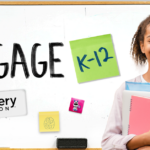By Tracy Gray and Alise Crossland
What is Digital Accessibility?
A growing number of teachers, administrators and policymakers recognize that digital accessibility is essential in their efforts to provide equal educational opportunity for all students, particularly those with disabilities. The concept of digital accessibility includes the design of materials (e.g., curricula, tests and resources), hardware (e.g., tablets and smart phones), software, and platforms (e.g., websites and online learning opportunities) to meet the needs of students (and families) with a wide variety of abilities and skills. The idea of accessible design and practice of accessible development ensures both “direct access” (i.e., unassisted) and “indirect access” (supported with assistive technology devices like screen readers, augmentative and alternative devices, wearables).
Digital accessibility ensures that users with disabilities can navigate, perceive, and interact with content. Digital content that is inaccessible violates the Americans with Disabilities Act (ADA), and hinders our ability to provide equal educational opportunity for all learners. Content that is designed to be accessible and inclusive benefits all students, including English language learners and struggling students.
With the use of accessible technology, embedded supports such as closed captions, text-to-speech, word prediction and adjustable reading levels can help the teacher differentiate and personalize instruction to adapt to needs of the learner. In combination with assistive technology supports, teachers and students can employ appropriate accessibility features to improve access across the spectrum of student challenges that can affect learning, including cognitive, visual, auditory, neurological and physical disabilities.
We can see the power of accessible technology in action with Ms. Snyder’s fifth grade classroom in Minneapolis, when she clicks on the “CC” icon on the YouTube video that starts the closed-captioning at the bottom of the screen. In addition to providing access for her student with a hearing impairment, her students learning English use the captions as an extra support to help them connect the audio with the visual representation of text. Her struggling readers grow their skills with the additional exposure to text, as they follow along on screen while listening to the audio. Her students with difficulty processing auditory information use the captions to reinforce what they’re hearing. With the simple addition of one accessibility feature, Ms. Snyder has made her learning environment more inclusive, and differentiated the lesson for a wide variety of learners.
Inclusive Learning Environments
Creating accessible and inclusive environments without barriers enables teachers and students to focus on the main objectives of learning, skills development and confidence building. While there will always be the need for specialized accommodations, there is growing recognition that the supports necessary for accessible learning can be incorporated in hardware and software from the onset of the development process. This approach, known as “born accessible” is based on the architectural principles of universal or inclusive design. As with closed-captions, the often-cited example of curb cuts is used to illustrate an accommodation that was initially intended to help individuals with disabilities, but provides supports for bikers and families with strollers. While this feature was initially designed as an accommodation for a specific segment of individuals, it has since become a standard that benefits everyone.
Applying this concept to creating inclusive educational environments, we see the increased recognition and integration of universal design for learning (UDL). UDL promotes the development of materials, tools, practices and services that are usable by people with the broadest range of abilities, operating within the widest range of educational settings. The three guiding principles of UDL focus on ensuring accessibility and strengthening teaching and learning through multiple means of:
- Representation so that students can approach information in more than one way (includes digital books, websites, hardware, software and screen readers that may feature text-to-speech, availability of different reading levels, changeable color contrast, alterable text size, or a combination of these features.
- Expression so that all students can demonstrate and express what they know. This includes options in how students express their learning, when appropriate, such as writing, videos, speech-to-text programs and online concept mapping.
- Engagement to stimulate interest in and motivation for learning. This includes offering students the option across different learning activities or content for a particular competency or skill and providing opportunities for greater scaffolding and collaboration.
These UDL principles should guide the development and refinement of digital learning tools and resources so that accessibility features are integrated from the start. In a similar vein, many of the learning materials used in today’s classroom are created by teachers and staff. This practice has been made possible by the availability and improved ease of authoring tools. Teachers and staff need to be encouraged to look for tools that include options for adding accessibility and follow standards such as those offered in the Web Content Accessibility Guidelines (WCAG). The WCAG serves as the international standard for making web content accessible and is the foundation for many national accessibility laws, including Section 508 in the U.S.
Following these guidelines, there are numerous user-friendly tools to develop or enhance content so that it is accessible for the widest range of students, such as:
- Captions for videos
- Alt-text (that is, an inserted word or phrase to describe an image) on websites and in e-books
- Standard headers in websites, forms, e-books and documents
- Adjustment of text colors and background contrasts
- Text-to-speech, speech-to-text, dictionaries, and glossaries
As more educational content, products and services are made available in digital formats and delivered online, the issues of accessibility need to be front and center as part of the development and procurement process since it is a key component in the delivery of equal educational opportunity to meet the needs of all students.
Suggested Resources
- Digital Accessibility Toolkit: What Education Leaders Need to Know
- Getting Started with Accessibility
- 5 Things to Know About Your Role in Ensuring Accessibility
- Accessibility is More Than a Checklist
- Making Content Accessible for All Students
- Accessibility Tools and Resources: Getting Started with Accessibility
About the Authors
Tracy Gray, Ph.D., is a managing director at American Institutes for Research (AIR). She has led four national technology centers funded by the U.S. Department of Education, Office of Special Education Programs. She is national expert on leveraging technology to enhance teaching and learning, with an emphasis on students with disabilities. Alise Crossland, M.S. Ed., Ed.S, is a senior researcher at AIR with more than a decade of experience identifying and assessing digital learning technologies for both general and special education. Together, Dr. Gray and Ms. Crossland have led technical assistance activities for states and districts (LEAs) through the The Center on Technology and Disability, and PowerUp WHAT WORKS, focused on supporting educators in integrating accessible technology tools to facilitate access to academic content for all students, particularly those with disabilities. They also led the development of the 2017 National Education Technology Plan for the U.S. Department of Education.
The American Consortium for Equity in Education, publisher of the "Equity & Access" journal, celebrates and connects the educators, associations, community partners and industry leaders who are working to solve problems and create a more equitable environment for historically underserved pre K-12 students throughout the United States.
- American Consortium for Equity in Educationhttps://ace-ed.org/author/admin/
- American Consortium for Equity in Educationhttps://ace-ed.org/author/admin/April 23, 2025
- American Consortium for Equity in Educationhttps://ace-ed.org/author/admin/
- American Consortium for Equity in Educationhttps://ace-ed.org/author/admin/







